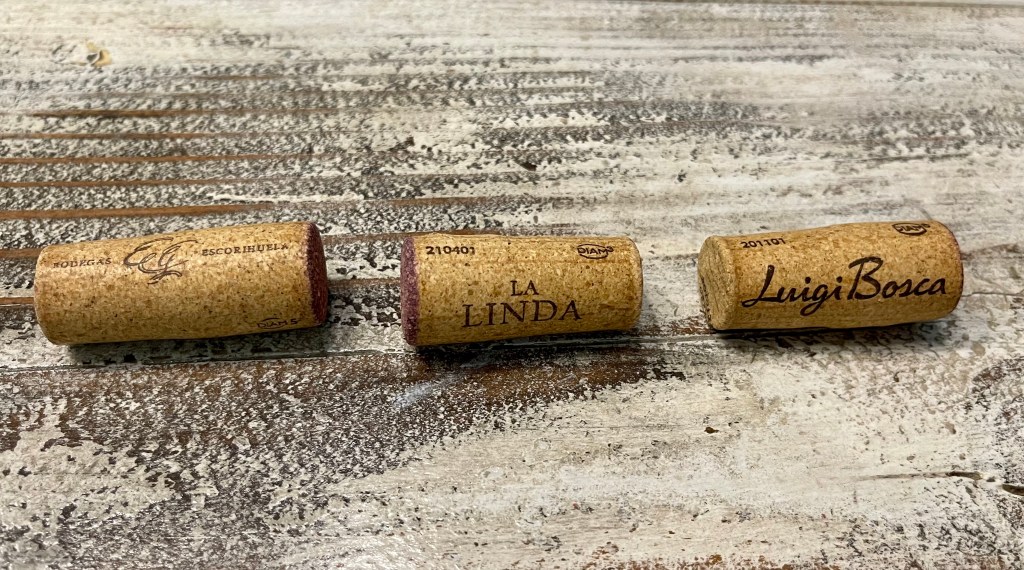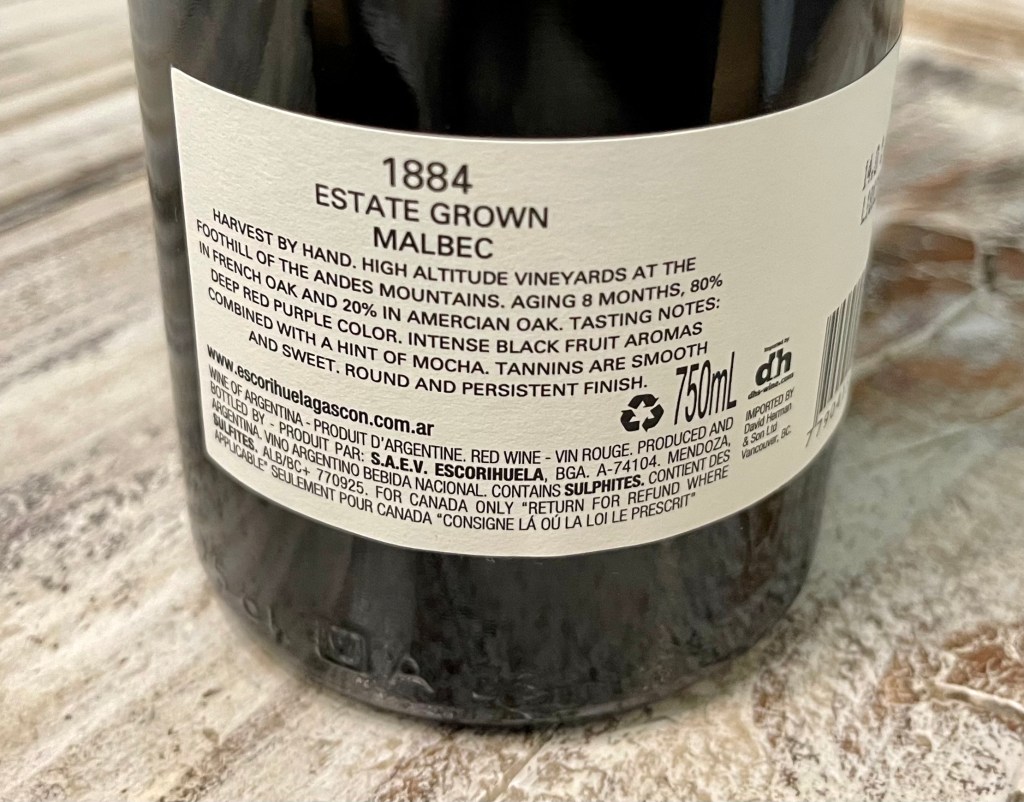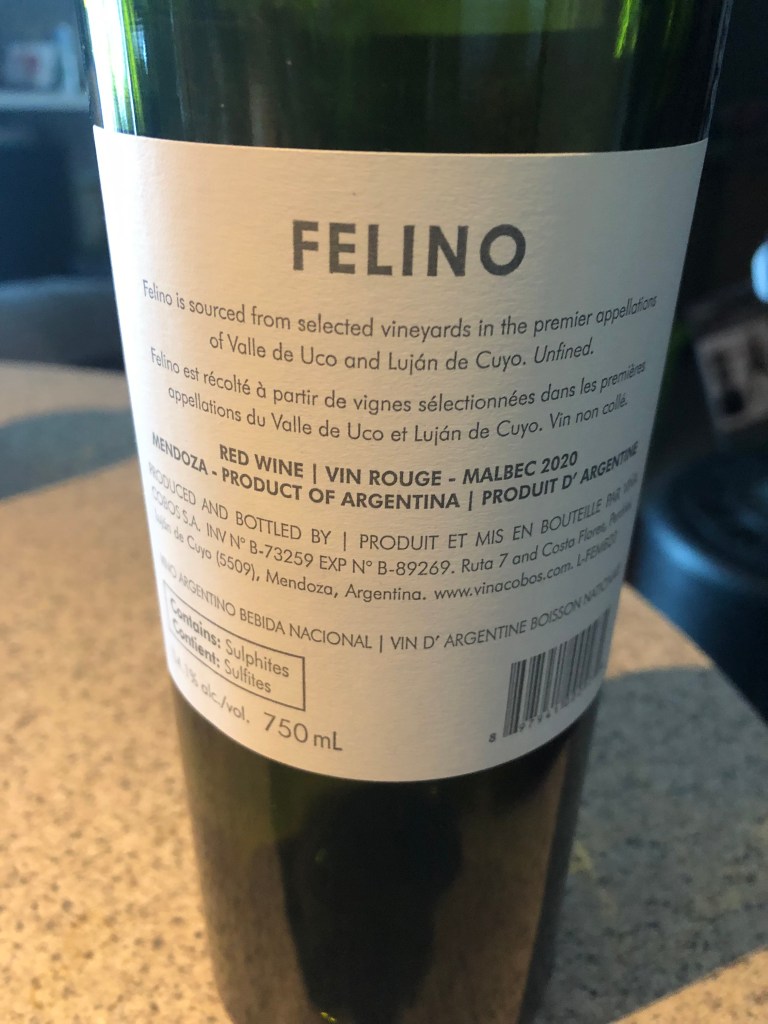By Peter Vetsch and Raymond Lamontagne
[These bottles were provided as samples for review purposes.]
Everyone’s favourite proclaimed and grammatically questionable vinous holiday has returned: April 17th, 2022 marks the 11th annual Malbec World Day, which should almost certainly be “World Malbec Day” in its English formulation but officially is not. Unfortunately for this grandiose occasion, it happens to share the stage this year with an even bigger (and actually statutory) holiday whose date roves yearly with the lunar calendar. Happy Easter, everybody: if your Malbec attention span is absorbed somewhat by Mini Eggs and chocolate rabbits and faith-based celebrations, well, fair enough, but maybe crack some Argentinian flagships with your ham tonight anyway. Unlike Easter, whose shifting date is tied to the first full moon after vernal equinox for reasons entirely unknown, Malbec World Day is always on April 17th, because on that day in 1853, Argentina’s President ordered that new French vine cuttings be brought into the country, including the first Malbec vines to hit South America. Malbec World Day is thus heavily Argentina-focused, but then, for this moment at least, so is the grape.
Aside from killer marketing (seriously, check out the opening splash page on worldmalbecday.com), there are a few other reasons why Argentina has stumbled on something special with its rendition of this grape, all tied to the astoundingly unique geography of the region. The primary vine-growing region of Mendoza is in the foothills of the mighty Andes mountain range, placing it at some of the highest altitudes on Earth for viticulture, up to 11,000 feet above sea level. Due to this absurdly elevated positioning, vines see way more sunlight (there are no clouds when you’re above the clouds), enjoy frequent breezes off the mountains which help control pests, and experience massive temperature shifts between hot days and cold nights to preserve acid and extend grape hang time, which both maximizes and controls ripeness. The result is heaven for a big red that had previously struggled to find its place. We have a sextet of Argentina’s most famous export to help us celebrate this glorious holiday(s) in style. Which Malbec will take this year’s entry-level value wine crown this year?
2019 Escorihuela Gascon 1884 Malbec (~$19)
Although I have seen them literally hundreds of times in stores, this is the first time I have ever had a 1884 Malbec, so named because Escorihuela Gascon is the oldest winery in the city of Mendoza, founded in that very same year, 31 years after Malbec reached Argentina’s shores. They lean hard into this history: the restaurant on premise at the winery is even called 1884 Restaurante. Gascon produces a wide array of releases and tiers, but the entry-level 1884 lineup is definitely the best-known of the bunch. These Malbec grapes were hand-harvested (a pleasantly common characteristic in Argentinian wine, likely and less bucolically because labour is cheaper there than most places), and 60% of the final blend spends 8 months in 80% French and 20% American oak before bottling.
Malbec #1 is surprisingly largely translucent in the glass and emerges aromatically punchy, melding tangy blackcurrant and blueberry fruit with Wine Gums zing, hot rocks, smoke and coffee grounds. The sweet pure dark fruit palate is flecked with balsamic undertones, the silky mouthfeel and smooth tannin resulting in a welterweight and unobtrusive profile. This makes a pleasing first impression, with the bulk of the fruit singing on the attack, and then largely stays out of the way until a slightly bitter finish. It’s not grandiose or next-level, but it’s bouncy and fun, in a Tuesday-evening sort of way.
86 points

2019 Luigi Bosca La Linda Private Selection Old Vines Malbec (~$19)
OK, first off: way too many qualifiers and adjectives in the wine name. Control yourself a bit, Luigi Bosca. This is another winery with an “oldest” designation to its credit: it is the oldest family-owned winery in Argentina, dating back to its founding in 1901 by Don Leoncio Arizu. The property is now run by the 3rd and 4th generation of the Arizu family, which may not quite compare to some French winery lineages, but which is pretty damn impressive for the New World. La Linda is the entry-level lineup from Luigi Bosca, featuring fruit-focused (read: limited-oak) renditions of key varietals. This Malbec was estate-grown at about 1 km of altitude, then fermented entirely in stainless steel tanks and partly matured in 2nd and 3rd-fill used French oak barrels for 8 months.
Noticeably darker and more purple than the 1884, this reads as more serious from the get-go. The less exuberant, smouldering nose is a study in black: blackberry, new tire treads, black jellybean and topsoil, brushed with violet and sagebrush, and with a hint of counterintuitive tropical fruit lingering around the edges. It features much more palate presence and authority than its $19 competitor above, the tannins firmer and more entrenched, the fruit more striking. This handily wins the sub-$20 category, although it could use an acid boost for additional invigoration.
87 points

2018 Luigi Bosca Malbec (~$24)
See, wasn’t that an easier wine description? Three words. Boom. This is strangely the exact same wine that Ray and I were given to celebrate Malbec World Day last year, and I promise that I (Peter) have not looked at his notes when preparing my own. As is often the case in the world of entry-level wines, an extra $5 can often go a very long way, and here it takes you to a whole new quality tier, featuring older vines (yes, older than the “Old Vines” bottle above, although those are old too), biodynamic farming and a longer maturation period in French oak.
The additional year of bottle age on this release has allowed its opaque Death Star darkness to step back slightly to a deep ruby-purple. It is immediately a different beast than the others: rounder, smoother and more stately thanks to rolling aromatic waves of cedar forest, ripe blackberry, tomato leaf, allspice and digestive biscuits. This depth carries into the spicy palate, where the complexity ratchets up a notch and a cultured, luxurious mouthfeel reveals itself as the clear calling card for this bottle. A pleasantly extended finish only confirms the key truth that clearing the $20 barrier can pay serious dividends without much additional expense.
89 points
2020 Vina Cobos Felino Malbec (~$25)
Not Malbec’ed out yet? Of course you aren’t. We are exactly halfway through our samples, and the moniker “FELINO” stares me down from this intricately textured label, as if daring me to cannonball straight into its purple environs. Vina Cobos winemaker Paul Hobbs has been roaming both the Luján de Cuyo and Valle de Uco since 1988, locating sites that yield subtlety and balance above all else. Felino features hand-picked grapes from high altitude semi-desert vineyards in both the Luján de Cuyo and Valle de Uco, with the must fermented in stainless steel followed by ageing in 10% new American oak for 8 months. This light wood treatment ought to allow the purple goodness to take centre stage.
In fact this looks more dark ruby to me in the glass, albeit with decidedly purplish highlights. This is equal parts juicy and herbal, like someone smashed blueberries, plums and cherries both red and black, and perhaps a squirt of cassis into a basket of fresh oregano and thyme sprigs dusted with white pepper and a handful of old smoky cloves. This drinks exactly as billed: the low key oak treatment exerts just enough presence to season without marring in the slightest the cool climate fruits that at times lean toward the red raspberry end of the Malbec spectrum. Medium bodied with tannins that seem seamless at first, only to yield a scratchy, grainy accumulation over the course of subsequent sips. Although this won’t shift paradigms (nor is it supposed to), almost impossible not to like.
88- points
2018 Finca Decero Remolinos Vineyard Malbec (~$17)
Okay, I am super intrigued to try a $17 dollar single vineyard (!) Malbec. Today, however, Bacchus curries no favour. The wine is corked, and not subtly so. I’m talking rank mildew. Not scored (or even tasted). Moving on.
2019 Bodegas Salentein Reserve Malbec (~$21)
Lastly we have a classic example of the so-called reserva style of Argentinian Malbec. More noticeably black-fruited than entry level bottlings, such wines also see longer periods of oak ageing, with the chocolate and vanilla impressions to match. A pioneer of high-altitude winemaking in the Valle de Uco, Salentein enjoys the winemaking expertise of José Galante, often deemed the father of modern winemaking in Argentina. If anyone ought to know Malbec… this features grapes estate vineyards that together represent five different microclimates. This time the wine sees 12 months in a mix of French and American oak.
Now this is dark purple. The nose is a heady brew of blackberries, fresh prune plums (not dried), blackcurrant wine gums (almost to a Cabernet-like degree), pen ink, black liquorice, caraway seeds (think German rye bread), chewing tobacco, chocolate-covered almonds, and a strange but appealing confected vibe that vaguely recalls fruit punch sour straws or perhaps raspberry Jolly Ranchers. That this can project past the oak treatment is rather remarkable, yet fits NW Nick Jackson’s description of Malbec so very well: starts with sweet power and ends with a reasonably long tobacco (I say ashtray) finish. Drying tannins make their presence known. Jackson says they ought to congregate on the hinge of the jaw (!) but I’m getting more of a conventional Bordeaux-esque prickly on the gums experience. This is how you $21 Malbec. See you next year.
89+ points











Leave a comment